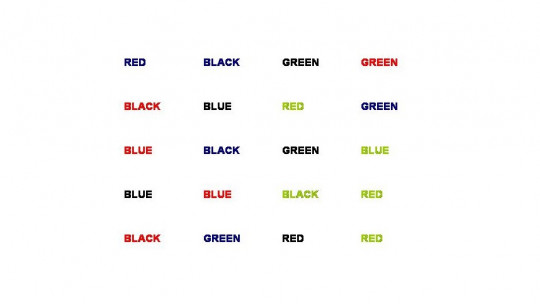
Human beings tend, through learning, to get used to performing certain actions. Eating, writing, reading or cycling: all are processes that initially require our full attention, but which we end up automating.
Generally this automation helps us save resources, but the truth is that sometimes it can be disadvantageous. This is what happens when we are asked for a task in which stimuli appear that elicit the automated response, but asking us to do something else. We must stop the automatism to carry out the real task. One way to measure this interference is the Stroop test..
The Stroop test
The Stroop test is a psychological test linked especially to neuropsychology which allows measuring the level of interference generated by automation in the performance of a task.
Also called the Colors and Words Test, it was developed by Golden with the intention of assess aspects such as selective attention and inhibitory control, when it was observed that people who knew how to read tended to take longer to read the color in which the words were written than to read the name of said colors (because their reading was more automated). It also allows you to assess the processing speed
The duration of the application of this test is relatively short about five minutes, and is designed for people between seven and eighty years of age.
Although it consists of three phases, the best known part and the one that has the greatest use is the one based on the reading of the word that designates a color written in a color different from the one it expresses, so that the subject has to inhibit automatic reading response in order to be able to correctly designate the color with which the words are written.
The three phases or tasks
Throughout the Stroop test, a total of three different tasks are done, through three sheets in which five columns of 20 elements appear. Each of the tasks is carried out for a certain time (for example, forty-five seconds), with successes noted for subsequent evaluation.
1. Reading words
First, the subject is provided with a list with the names of three colors (red, blue, and green) written in black, and they are asked to read them.
2. Color identification task
The second task is color identification, in which the observer is provided with a list in which colored meaningless symbols appear. The subject is asked to identify and name the color of each of the elements.
3. Interference task
Finally, the third and most representative task of the Stroop test is based on the principle of interference, offering the subject a list of words with the name of the previously mentioned colors, but on this occasion written with a color different from the one the word refers to. For example, the word BLUE appears written in red. The subject must name the color in which each element is written.
Interpretation of the Stroop test
The data collected through the Stroop test must be analyzed. The correct answers that the subject has had during the test or by the time it takes to react to stimulation paying attention to what is reflected in each of the sheets or tasks.
In the third test we can observe the subject’s reaction time, which tells us aspects such as the interference produced by different aspects of the same stimulation the ability to resist it, the management of cognitive and attentional resources or the perseveration and repetition of behaviors.
Interference effect
An estimate of the approximate score that a subject should obtain in the third test can be calculated from the quotient of the product of the words read in the first test by the colors in the second test divided by their sum.
If we subtract the estimated score from the actual score obtained in the interference task, we can observe whether the person correctly inhibits the response (values greater than 0, positive) or whether there are significant interference problems (if it is a negative value). Generally, the majority of the population obtains scores between 10 and -10.
However, This estimate may be biased if the subject has a very low or very high level of experience in reading (the value of the answers in the first test and the performance in the third may vary depending on whether we are more or less accustomed to reading)
Possible indications of brain damage
Furthermore, each of them can provide important information regarding brain functioning, although the test in question does not allow a specific interpretation if there are a large number of errors in all of them.
In the reading task, errors usually appear in those subjects with problems in the left hemisphere, specialized in language. Especially in the case of injuries to the supramarginal and angular gyri.
On the other hand, the color naming task allows us to detect if there are problems in the right hemisphere.
The interference task usually shows lower results than the previous ones in almost the entire population, but sometimes it can be observed the existence of perseverance in making mistakes which could be indicating an involvement in the frontal or basal ganglia.
Area of application
The main scope of application of this test is neuropsychological evaluation. And it is that allows obtaining a measure of attention and executive functions such as inhibitory behavioral control.
Specifically, it is frequently used to observe the effects of a brain injury or to assess whether certain brain areas such as the frontal lobe are affected. In addition to lesions, it can assess the executive functions of patients with dementias such as Alzheimer’s and Huntington’s Korea.
Although it is not as common as in the previous cases, it can also be used in the assessment of the abilities of people with different mental disorders, such as schizophrenia or, more frequently, ADHD.
Bibliographic references:
- Almendro, MT (2012). Psychotherapies. CEDE PIR Preparation Manual, 06. CEDE: Madrid.








